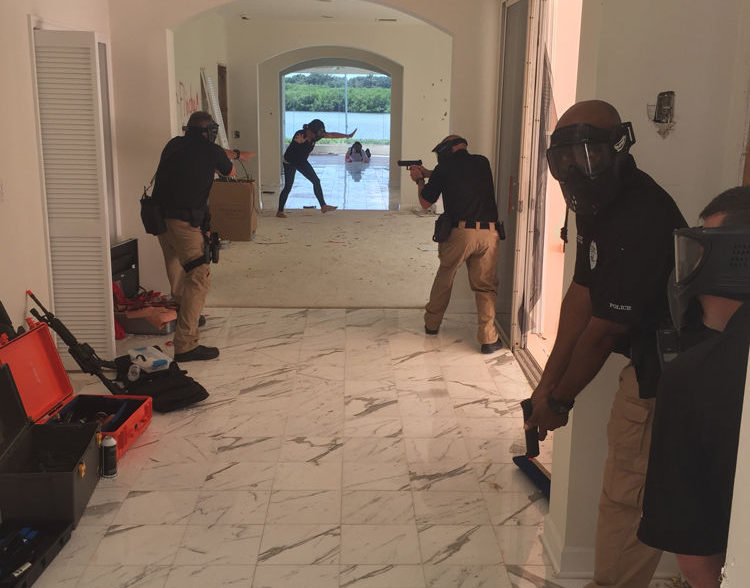
INDIAN RIVER SHORES — Tragedies like the Orlando Pulse nightclub shooting have agencies far and wide upping their training for handling active-shooter incidents and Indian River Shores Public Safety officers want to be ready, too, in the unlikely event a shooting incident happens on the barrier island on their watch.
This week’s training was slightly different than previous scenarios, as the focus this time was not only on taking down an armed perpetrator, but also on stopping the bleeding from gunshot wounds, gashes from knives and other injuries. The Shores officers, being triple-trained as police, paramedics and firefighters are uniquely positioned to render quick aid to victims in danger of bleeding out on a crime scene. As soon as the scene is secured, officers can immediately put their paramedic hats on and engage their life-saving skills.
“With what is sadly becoming the norm in emergency response, agencies need to train and practice these skills, not just as a single agency but with multi-agencies as well, because we don’t know what we are going to confront,” said Shores Lt. Tony Dudley.
Among the tests thrown at the officers was the challenge of responding to a call that a male subject had returned home to find his wife with another man. Officers encountered a live shooter, also armed with a knife, who had injured the other man; officers needed to take down the shooter, safely remove the wife from the scene and immediately begin treating the wounded man to stop his bleeding.
Later on in the training, Shores officers came upon a house party gone bad, where a shooter had attacked from the back yard through a French door opening onto a patio. Officers had to assess the situation, track down and neutralize the shooter, and then treat the shooting victim. If an officer was “shot” with Airsoft gun pellets, his colleagues also had to perform triage and keep him stable enough for transport.
Officers had to find hidden shooters and deal with emotional victims, a drug deal gone bad, and even nosy neighbors who police call “lookie loos” getting in their way and trying to get into the ambulance to check on the patient. All of this while trying to keep the stabbing or shooting victim or victims alive.
Preventing bleeding deaths before victims or injured officers can get to the emergency room was the mission of the Shores’ trainers this week, according to Dave Schmitt who heads up the Tactical Emergency Casualty Care training team from HealthFirst Holmes Regional Medical Center. “It’s the civilian version of the military’s Combat Casualty Care.”
Schmitt said his team has trained more than 1,100 first responders in these tactics since March 2012, and that HealthFirst has provided more than $100,000 in free training to local law enforcement.
“The reason we do this is because bleeding is the number one preventable cause of death in trauma,” Schmitt said. “After we leave this week, we’ll continue working with Indian River Shores to train because these are perishable skills that if you don’t use them, you lose them.”
The Shores often uses homes set for demolition or being gutted as training grounds and this week was no exception, with an immense Palmetto Point pool home being the backdrop for physical and mental drills designed to expand the critical-thinking skills of Shores’ officers in a crisis, and to give them practice in handling a live-shooter situation and caring for gunshot wounds – all while in a heightened state due to adrenaline and the natural phenomena of “tunnel vision” that officers get when working in emotionally charged atmospheres with lots of action going on. To enhance the urgency of the bleeding-victim aspect of the drills, and to make the training more realistic, the team used a great deal of fake blood to amp-up the experience for the officers and paramedics.
Joining Schmitt on the training team were Melbourne Police Officer Mike Schmid, Cocoa Police officer Mike Cavaleiri – an Iraqi veteran of the U.S. Army and combat medic – and Osceola County Sheriff’s Office deputy Chris Donaldson, who is also affiliated with the Army’s Counter Terrorism Unit.
Cavaleiri played the role of the shooter in most scenarios and Schmid wore a specially made blood-pack that spewed fake blood from his staged wounds to test the officers’ ability to apply a tourniquet and stop his bleeding. This is not something officers get a great deal of practice doing, but the TECC Team members subject themselves to bruises from tight tourniquets several times a day to provide a real, human subject on which to practice.
Schmitt said any tragic scenario like the Orlando Pulse mass-shooting provides yet another set of unimaginable circumstances to train for – things that officers 10 or 20 years ago might not think of as even a remote possibility. “We learn from every public tragedy,” Schmitt said.
“If we cannot prevent these things from happening, the only thing we can responsibly do after a tragedy is to glean lessons learned. What could have been done differently, or what could we have trained better for, to have a better response next time,” Schmitt said.
Shores officers completing the training will be awarded the Tactical Emergency Casualty Care (TECC) certification and earn continuing education credits toward keeping up their paramedic licenses.



